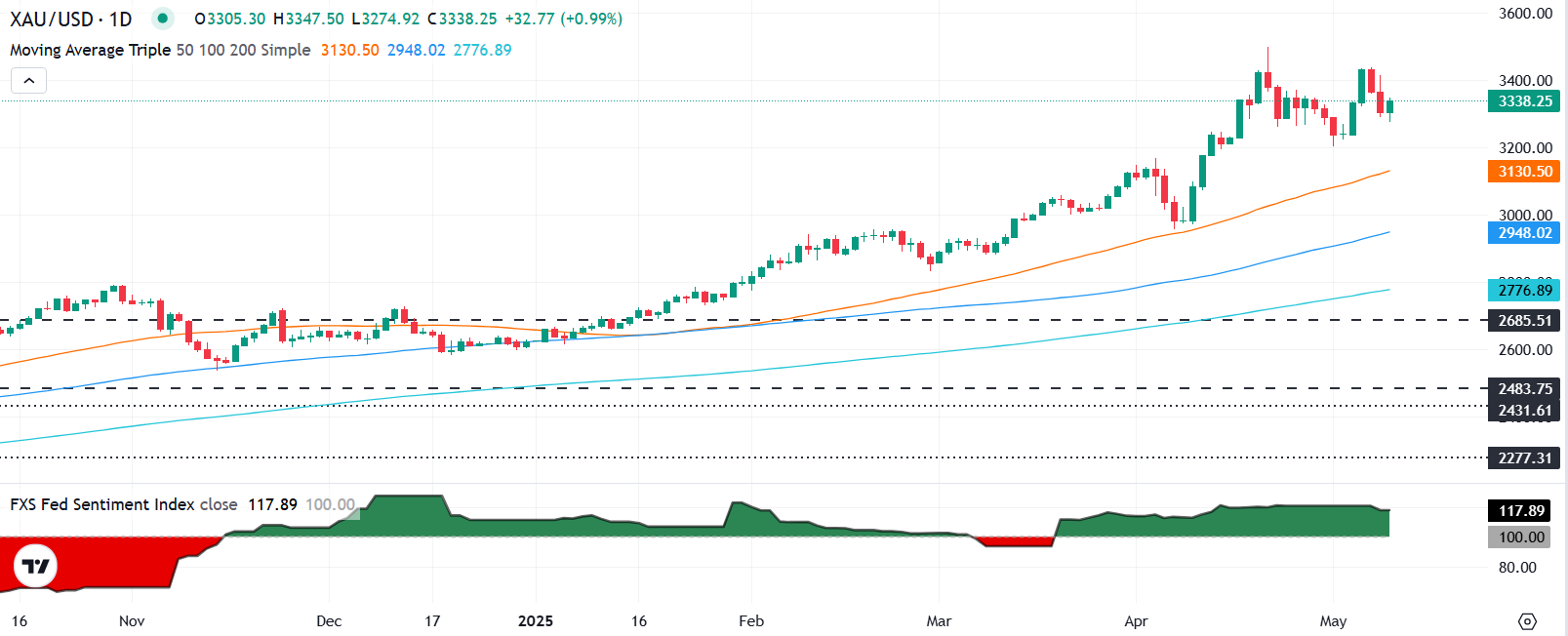Gold price rises over 1% on USD weakness as geopolitical tensions rise
- DXY drops 0.32% to 100.31 as US yields slip, boosting appeal for non-yielding assets like Gold.
- Trump hints at 80% China tariff; markets brace for pivotal trade talks in Switzerland.
- India-Pakistan conflict escalates, reinforcing safe-haven flows amid global risk aversion.
Gold price climbed over 1% on Friday as the US Dollar (USD) retreated after posting two days of gains, weighed by lower US yields. A deterioration in risk appetite boosted Bullion prices, which are being underpinned by geopolitical concerns. At the time of writing, XAU/USD trades at $3,338.
Wall Street registers losses as traders brace for the meeting between the China and US delegations in Switzerland on Saturday. Although expectations are high that the trade war sustained by both countries could de-escalate, investors remained cautious ahead of the talks.
US President Donald Trump said that “80% Tariff on China seems right! Up to Scott B,” via a social media post on Friday.
Bullion prices remain high as hostilities between India and Pakistan have heightened. Both countries are accusing each other of using drones and artillery on the third day of the conflict.
The US Dollar Index (DXY), which tracks the buck’s value against a basket of six currencies, hurdled the 100.00 figure and is down 0.32% at 100.31, a tailwind for the yellow metal.
A slew of Federal Reserve (Fed) officials had crossed the wires on Friday. Officials point to economic uncertainty and trade policy risks, as US tariffs are inflation-prone and complicate the central bank's job of balancing its dual mandate goals.
Daily digest market movers: Gold price rises underpinned by low US Treasury yields.
- US Treasury bond yields are rising following the Fed’s decision on Wednesday. The US 10-year Treasury note yield remains firm at 4.371%. Meanwhile, US real yields are also steady at 2.81%, as indicated by the US 10-year Treasury Inflation-Protected Securities yields.
- The World Gold Council revealed that the People’s Bank of China (PBoC) added 2 tonnes to its Gold reserves in April, for the sixth consecutive month. The National Bank of Poland (NBP) increased 12 tonnes in April to 509 tonnes, while the Czech National Bank increased its reserves by 2.5 tonnes in April.
- Swap markets have so far priced in the Fed’s first 25 basis points (bps) rate cut for the July meeting, and they expect two additional reductions towards the end of the year.
XAU/USD technical outlook: Gold price jumps back above $3,300
Gold price rally paused as the yellow metal retreated below the $3,400 figure. Nevertheless, momentum indicates buyers are stepping in, as depicted by the Relative Strength Index (RSI), hinting that the non-yielding metal could test the next key resistance level at $3,350 on its way toward $3,400.
Conversely, Gold could retreat further on a daily close below $3,300, which could expose the May 1 cycle low of $3,202.

Gold FAQs
Gold has played a key role in human’s history as it has been widely used as a store of value and medium of exchange. Currently, apart from its shine and usage for jewelry, the precious metal is widely seen as a safe-haven asset, meaning that it is considered a good investment during turbulent times. Gold is also widely seen as a hedge against inflation and against depreciating currencies as it doesn’t rely on any specific issuer or government.
Central banks are the biggest Gold holders. In their aim to support their currencies in turbulent times, central banks tend to diversify their reserves and buy Gold to improve the perceived strength of the economy and the currency. High Gold reserves can be a source of trust for a country’s solvency. Central banks added 1,136 tonnes of Gold worth around $70 billion to their reserves in 2022, according to data from the World Gold Council. This is the highest yearly purchase since records began. Central banks from emerging economies such as China, India and Turkey are quickly increasing their Gold reserves.
Gold has an inverse correlation with the US Dollar and US Treasuries, which are both major reserve and safe-haven assets. When the Dollar depreciates, Gold tends to rise, enabling investors and central banks to diversify their assets in turbulent times. Gold is also inversely correlated with risk assets. A rally in the stock market tends to weaken Gold price, while sell-offs in riskier markets tend to favor the precious metal.
The price can move due to a wide range of factors. Geopolitical instability or fears of a deep recession can quickly make Gold price escalate due to its safe-haven status. As a yield-less asset, Gold tends to rise with lower interest rates, while higher cost of money usually weighs down on the yellow metal. Still, most moves depend on how the US Dollar (USD) behaves as the asset is priced in dollars (XAU/USD). A strong Dollar tends to keep the price of Gold controlled, whereas a weaker Dollar is likely to push Gold prices up.
